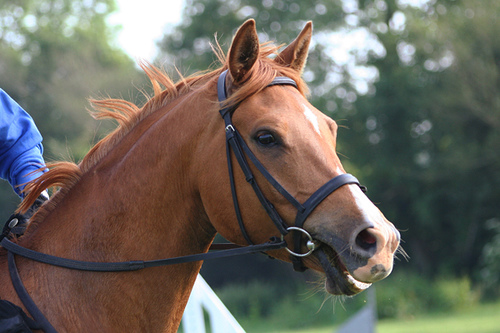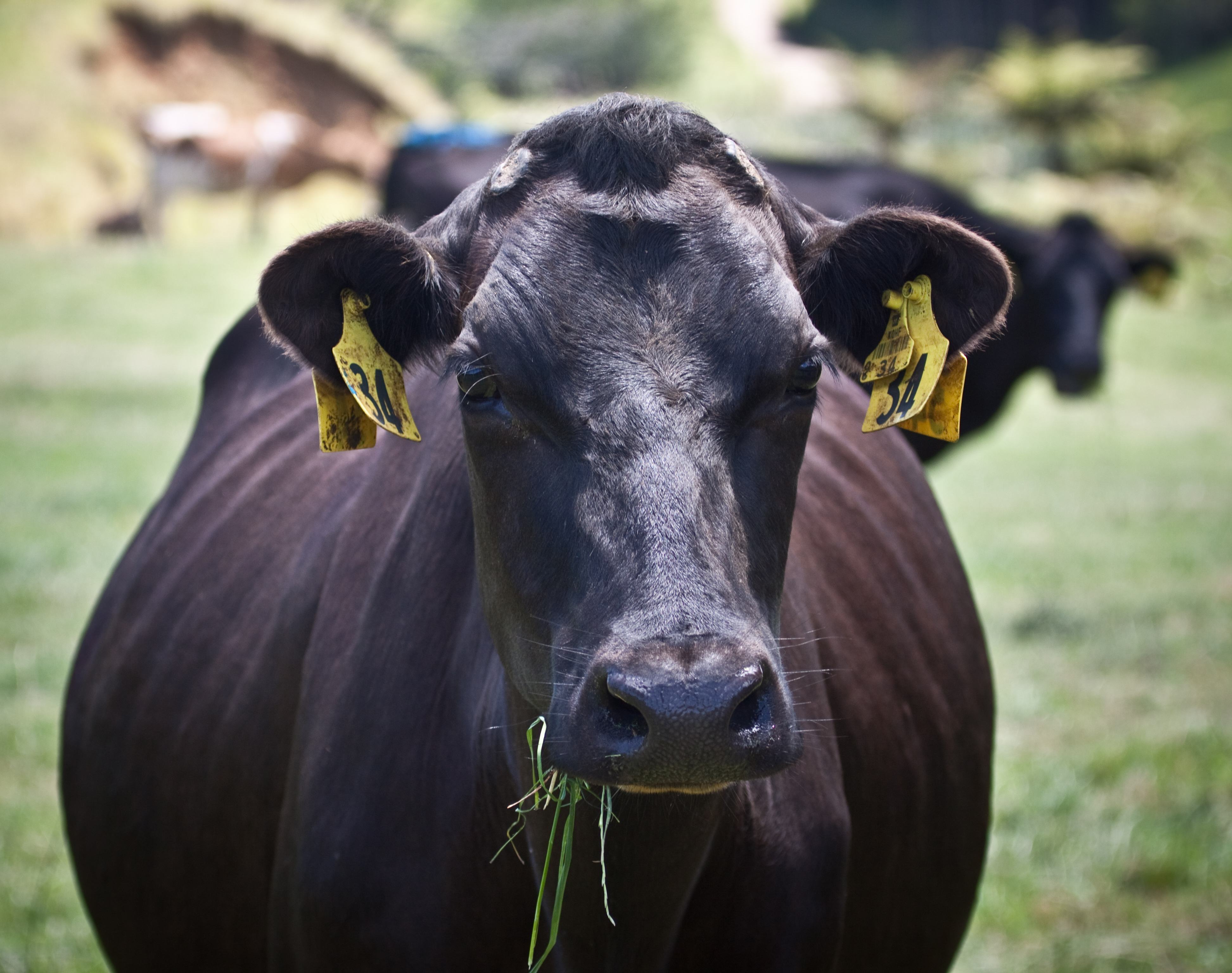|
Poll (horse)
The poll is a name of the part of an animal's head, alternatively referencing a point immediately behind or right between the ears. This area of the anatomy is of particular significance for the horse. Specifically, the "poll" refers to the occipital protrusion at the back of the skull. However, in common usage, many horsemen refer to the poll joint, between the atlas (C1) and skull as the poll. The area at the joint has a slight depression, and is a sensitive location. Thus, because the crownpiece of a bridle passes over the poll joint, a rider can indirectly exert pressure on the horse's poll by means of the reins, bit, and bridle. See also * Polled livestock Polled livestock are livestock without horns in species which are normally horned. The term refers to both breeds and strains that are naturally polled through selective breeding and also to naturally horned animals that have been disbudded. Na ..., for information on naturally or mechanically dehorned animals Re ... [...More Info...] [...Related Items...] OR: [Wikipedia] [Google] [Baidu] |
Koe Kop
Koe is a given name and a surname. Notable people with the name include: Surname * Amanda Lee Koe (born 1988), Singaporean-born American writer * Benjamin Koe (1816 – 1842), English cricket player * Fred Koe (born 1947), Canadian politician * Jamie Koe (born 1977), Canadian curler * Kenneth Koe (1925 – 2015), American chemist * Kevin Koe (born 1975), Canadian curler * Kerry Koe (born 1977), Canadian curler * Koe Yeet (born 1992), Malaysian actress Given name * Koe Wetzel (born 1992), American country music singer and songwriter {{given name, type=both ... [...More Info...] [...Related Items...] OR: [Wikipedia] [Google] [Baidu] |
Horse
The horse (''Equus ferus caballus'') is a domesticated, one-toed, hoofed mammal. It belongs to the taxonomic family Equidae and is one of two extant subspecies of ''Equus ferus''. The horse has evolved over the past 45 to 55 million years from a small multi-toed creature, '' Eohippus'', into the large, single-toed animal of today. Humans began domesticating horses around 4000 BCE in Central Asia, and their domestication is believed to have been widespread by 3000 BCE. Horses in the subspecies ''caballus'' are domesticated, although some domesticated populations live in the wild as feral horses. These feral populations are not true wild horses, which are horses that have never been domesticated. There is an extensive, specialized vocabulary used to describe equine-related concepts, covering everything from anatomy to life stages, size, colors, markings, breeds, locomotion, and behavior. Horses are adapted to run, allowing them to quickly escape predator ... [...More Info...] [...Related Items...] OR: [Wikipedia] [Google] [Baidu] |
Vertebral Column
The spinal column, also known as the vertebral column, spine or backbone, is the core part of the axial skeleton in vertebrates. The vertebral column is the defining and eponymous characteristic of the vertebrate. The spinal column is a segmented column of vertebrae that surrounds and protects the spinal cord. The vertebrae are separated by intervertebral discs in a series of cartilaginous joints. The dorsal portion of the spinal column houses the spinal canal, an elongated body cavity, cavity formed by the alignment of the vertebral neural arches that encloses and protects the spinal cord, with spinal nerves exiting via the intervertebral foramina to innervate each body segment. There are around 50,000 species of animals that have a vertebral column. The human spine is one of the most-studied examples, as the general structure of human vertebrae is fairly homology (biology), typical of that found in other mammals, reptiles, and birds. The shape of the vertebral body does, howev ... [...More Info...] [...Related Items...] OR: [Wikipedia] [Google] [Baidu] |
Bridle
A bridle is a piece of equipment used to direct a horse. As defined in the ''Oxford English Dictionary'', the "bridle" includes both the that holds a bit that goes in the mouth of a horse, and the reins that are attached to the bit. It provides additional control and communication through rein pressure (Oxford English Dictionary, n.d., para. 1). Headgear without a bit that uses a noseband to control a horse is called a hackamore, or, in some areas, a bitless bridle. There are many different designs with many different name variations, but all use a noseband that is designed to exert pressure on sensitive areas of the animal's face to provide direction and control. The bridle was devised by Indo-European herders of the Pontic-Caspian steppes to control horses between 3000 BC and 2000 BC. Parts The bridle consists of the following elements: * Crownpiece: The crownpiece, headstall (US) or headpiece (UK) goes over the horse's head just behind the animal's ears, at the pol ... [...More Info...] [...Related Items...] OR: [Wikipedia] [Google] [Baidu] |
Equestrianism
Equestrianism (from Latin , , , 'horseman', 'horse'), commonly known as horse riding ( Commonwealth English) or horseback riding (American English), includes the disciplines of riding, driving, and vaulting. This broad description includes the use of horses for practical working purposes, transportation, recreational activities, artistic or cultural exercises, and competitive sport. Overview of equestrian activities Horses are trained and ridden for practical working purposes, such as in police work or for controlling herd animals on a ranch. They are also used in competitive sports including dressage, endurance riding, eventing, reining, show jumping, tent pegging, vaulting, polo, horse racing, driving, and rodeo (see additional equestrian sports listed later in this article for more examples). Some popular forms of competition are grouped together at horse shows where horses perform in a wide variety of disciplines. Horses (and other equids such as mules ... [...More Info...] [...Related Items...] OR: [Wikipedia] [Google] [Baidu] |
Rein
Reins are used to direct a horse (or other animal) when riding or driving. They are attached to a bridle's bit or noseband and are made of leather, nylon, or other materials. Reins are used to give subtle commands or cues—also known as rein aids—to ask for a turn, a slower speed, a halt, or to go backwards. Types Other uses The word "rein" is sometimes used incorrectly to refer to a lead rope or a longe line, neither of which are reins. The idiom " rein in" means to hold back, slow down, control or limit; often misspelled as " reign in". The idiom " free rein" means to give or allow complete freedom, in action and decision, over something. See also *Horse tack * Neck rein *Riding aids Riding aids are the cues a rider gives to a horse to communicate what they want the animal to do. Riding aids are broken into the ''natural aids'' and the ''artificial aids''. Natural aids ''Natural aids'' are those of the rider's body, a ... [...More Info...] [...Related Items...] OR: [Wikipedia] [Google] [Baidu] |
Bit (horse)
The bit is an item of a horse tack, horse's tack. It usually refers to the assembly of components that contacts and controls the horse's mouth, and includes the shanks, rings, cheekpads and mullen, all described here below, but it also sometimes simply refers to the ''mullen'', the piece that fits inside the horse's mouth. The mullen extends across the horse's mouth and rests on the ''bars'', the region between the incisors and molars where there are no horse teeth, teeth. The bit is located on the horse's head by the , and which has itself several components to allow the most comfortable adjustment of bit location and control. The bit, bridle and reins function together to give control of the horse's head to the rider. The bit applies pressure to the horse's mouth, and reinforces the other control signals from the rider's legs and weight distribution. A well schooled horse needs little pressure on the bit from a skilled rider. Studies have indicated that soft, consistent bit co ... [...More Info...] [...Related Items...] OR: [Wikipedia] [Google] [Baidu] |
Polled Livestock
Polled livestock are livestock without horns in species which are normally horned. The term refers to both breeds and strains that are naturally polled through selective breeding and also to naturally horned animals that have been disbudded. Natural polling occurs in cattle, yaks, water buffalo, and goats, and in these animals it affects both sexes equally; in sheep, by contrast, both sexes may be horned, both polled, or only the females polled. The history of breeding polled livestock starts about 6000 years BC. Terminology The archaic term or is sometimes used to refer to hornless livestock (especially cattle) in folk songs, folk tales, and poetry, and in the name of the polled Irish Moiled cattle breed. "Muley" derives from Irish and Scottish Gaelic ''maol'', and Welsh ''moel''. Genetics In cattle, the polled allele is genetically dominant to that for horns. The polled trait is far more common in beef breeds than in dairy breeds. CRISPR technology is being develope ... [...More Info...] [...Related Items...] OR: [Wikipedia] [Google] [Baidu] |
Cattle Dehorning
Dehorning is the process of removing the horns of livestock. Cattle, sheep, and goats are sometimes dehorned for economic and safety reasons. Disbudding is a different process with similar results; it cauterizes and thus destroys horn buds before they have grown into horns. Disbudding is commonly performed early in an animal's life, as are other procedures such as docking and castration. In some cases, it can be unnecessary. Many breeds of cattle and sheep are naturally hornless. The polled gene can occur naturally, and certain breeds lack horns. Although polling is common among cattle and sheep, some varieties of livestock species cannot easily be bred to lack horns naturally. In one case, the poll gene in goats was linked to hermaphrodism in a single study several decades ago, although fertile polled goats have been bred. Horns are removed because they can pose a risk to humans, other animals and to the bearers of the horns themselves (horns are sometimes caught in fences o ... [...More Info...] [...Related Items...] OR: [Wikipedia] [Google] [Baidu] |






